2021-04-27 16:35:14
#Animal_Husbandry
#Nabard #Afo
Naked neck is? - *Indian chicken breed*
Which breed is for game purpose? - *Aseel*
What is the body temperature of hen? - *107°F*
Calving interval in cows should not be more than? - *16-17 months*
Which medicine is used for naval treatment? - *Tincture Iodine*
Inbreeding or line breeding decreases? - *Variation*
Crossbreeding increases? - *Production Hybrid vigour Body weight*
Mating among unrelated pure breed animals within the breed is called? - *Out crossing*
Join agriculture exams library telegram channel
Starter feed contains maximum of? - *Protein*
Most dangerous disease of chicken is? - *Ranikhet*
Which disease spread through virus in cattle is? - *Foot and Mouth disease*
Anthrax is caused by? - *Bacteria*
Severe bloat is removed by tools? - *Trocar cannula*
Which is the best method of milking? - *Full hand method*
What is the boiling point of milk (in Celsius) is? - >100
Which factors affects the composition of milk is? - *Species, Breeds Feeds*
Which harmon helps in let down of milk? - *Oxytocin*
Agriculture Exams Library
This channel Goal is to provide agriculture current affair's, agriculture events , notes , pdfs for students related to upcoming exams...
https://t.me/agricultureexams2020
2.2K views13:35


